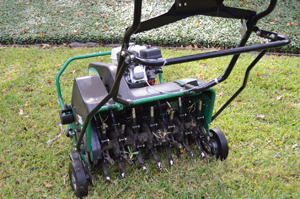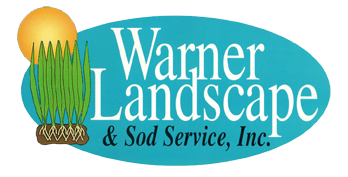Lawn Aeration Services
Chesterfield Twp., MI We know you care about your lawn and you want to keep it healthy and looking good. We feel the same way about your lawn and will do everything we can within our power to make sure this happens. But we need your help. About 10% of our customer’s core aerate their lawns annually. These lawns are usually healthier, thicker and look much better year round. Everyone should aerate their lawn at least every other year.
We know you care about your lawn and you want to keep it healthy and looking good. We feel the same way about your lawn and will do everything we can within our power to make sure this happens. But we need your help. About 10% of our customer’s core aerate their lawns annually. These lawns are usually healthier, thicker and look much better year round. Everyone should aerate their lawn at least every other year.Reasons to Core Aerate
- Thatchy lawns have more insect and disease problems.
- Thatch interferes with your lawns ability to use the fertilizers we apply.
- Poor watering results during warmer, drier weather.
- Heavy clay soils develop thatch twice as fast creating spongy turf.
Benefits of Core Aeration
- Your lawn can breathe.
- Increased root and plant growth (thicker lawn)
- Reduced soil compaction (less thatch development)
- Increases microbial action in your soil which actually helps break down thatch
- Better responses to the products you pay us to apply (a greener healthier lawn)
Quick Quote
DETHATCHING VS. CORE AERATION
For many years the only way to control thatch buildup in lawns was to dethatch/power rake. This process involved using a mechanical or powered device with blades or steel fingers that rip and tear into the lawn to try and remove excessive thatch build up. Normally, this was done in the Spring when the grass is just beginning to grow. As Turf Grass Managers, we now know that this is one of the worst things to do to a lawn. Especially in the Spring time.
There are two times of the year when your lawn produces most of its new root and plant growth (Spring and Fall). By dethatching, you not only tear through good turf growth but you also harm new root and plant growth, causing unnecessary stress to the rejuvenating plants.
WHAT IS THATCH?
As old grass plants die, their roots, rhizomes, and tillers create what we call Thatch Buildup. Some thatch is good, 1/2” or less. When thatch levels exceed this, several problems occur. 1) Roots grow easier in thatch then in soil creating a shallow root system. 2) Insects and disease organisms make thatch their home. 3) The lawn becomes less tolerant to heat stress and cold temperatures. Many people think that thatch is caused from excessive grass clippings being left on the lawn. Grass clippings do not cause or contribute to thatch buildup in any way. Clippings decompose very rapidly and basically disintegrate.
WHY WE RECOMMEND AERATION?
Extensive research has been done on the benefits of CORE AERATION. This process is completed using a gas powered machine with hollow tubes or tines which are attached to a drum. As the drum rolls the tines penetrate into the lawn pulling out plugs of grass plants, thatch, and soil. The plugs are left on the lawn and breakdown normally within 2 weeks through regular mowing and moisture. There are beneficial micro-organisms and nutrients in these plugs that will benefit your lawn. The holes from Core Aeration create an avenue for air, water, and fertilizers to reach the root system and greatly stimulate new root and plant growth. It also allows for deeper root penetration into the soil and loosens compacted hard soils. We highly recommend Core Aeration on all lawns as a means of controlling thatch buildup and allowing your lawn to use the nutrients, air, and water it deserves.
The Basics of Aeration
In the Midwest, spring is the time for the rebirth of your lawn, and one of the best ways to get it off to a good start and growing healthy again is through aeration. Sure, watering, fertilization and controlling weeds are big parts of the equation, but the most overlooked aspect is having a lawn properly aerated.
Every lawn needs to breathe, and although we don’t think of it that way, the truth is that compacted soil, thatch, and just general lawn build-up doesn’t allow nutrients to get to the roots, where they are needed. You can water and fertilize all you want, but if none of that gets to the roots, your lawn will never be as green and healthy as it could be.
In its simplest terms, aeration means to punch holes into the soil of your lawn. These holes allow water and nutrients to trickle down to the grass roots where they can be properly absorbed by the plants themselves. Plus, a heavily compacted lawn has nowhere to expand to, and if you’ve ever heard the term “root bound,” that’s exactly what can happen to a compacted lawn. By punching holes in the ground, you break up the soil, much like breaking up the soil in a garden with a trowel, which lets the plants take in food and grow.
Manual Aeration
You can go to any garden shop and get spiked shoes that you strap over your regular shoes, and then take a walk onto your lawn. In theory, they punch holes into the soil and break it up enough to make a difference. In practice, they aren’t all that effective. Why? The spikes are just too thin so that once the lawn becomes wet, the soil around the punched holes expands and essentially closes up the holes. Also, you would have to walk miles over your lawn just to punch in enough holes to really make a difference. Is it good exercise for you? Yes. Is it good exercise for your lawn? No.
Powered Aeration
The most effective way to aerate your lawn is by powered aeration. This is done with a gas powered machine which uses a rotating drum that literally removes half-inch plugs from your lawn. The plugs can be as long as 3 inches, and these holes will not readily close up when they are watered.
Each of these holes form a channel to the roots that easily allows water and nutrients to go deep, exactly where they need to be. Not only that, with each plug that is removed, it gives your lawn that much more space to expand and grow. Powered aeration gives your grass a chance to grow stronger, thicker and greener throughout the entire growing season.
The Time is Now
Although aeration will help your lawn during any part of the season, now is the time when it makes the most significant difference. Nutrients jump-start a lawn in the spring, and the best way to get them to the roots of your lawn is through aeration. The spring lawn rebirth is on its way, so make sure your lawn is aerated and ready for it.
At Warner Landscape and Sod, we pride ourselves on giving you the best service possible, and with over 20 years of servicing lawns, just like yours, we’ll get the job done right every time.
If you have any questions about what aeration can do for your lawn, please contact Warner Landscape & Sod. We are a full featured landscape and installation company servicing Chesterfield Twp., MI.
Servicing: Clinton Twp, Livonia, Macomb Twp, New Baltimore, Chesterfield, Chesterfield Twp., Harrison Twp., Warren, St. Clair Shores, Sterling Heights, Roseville, Grosse Pointe
